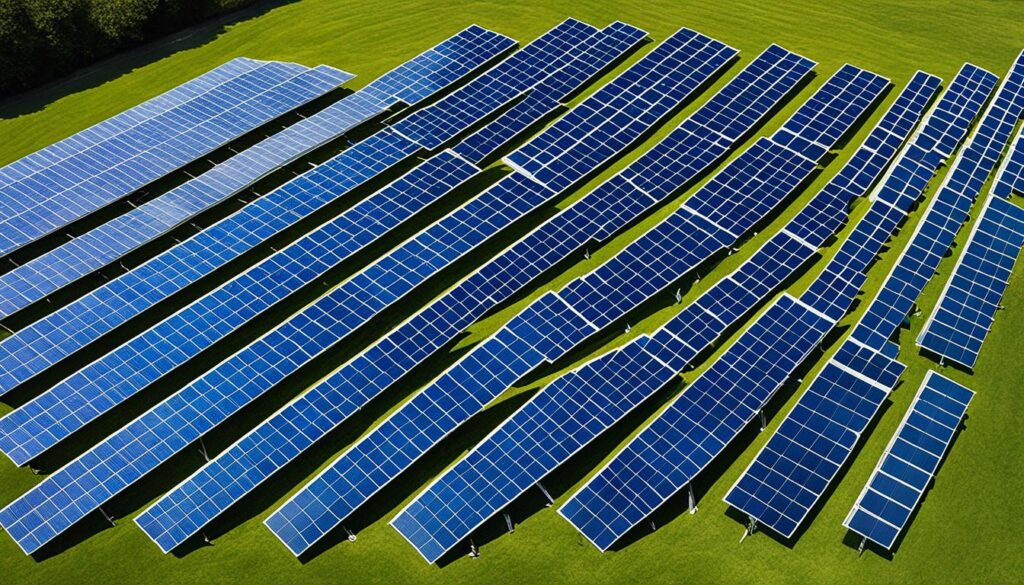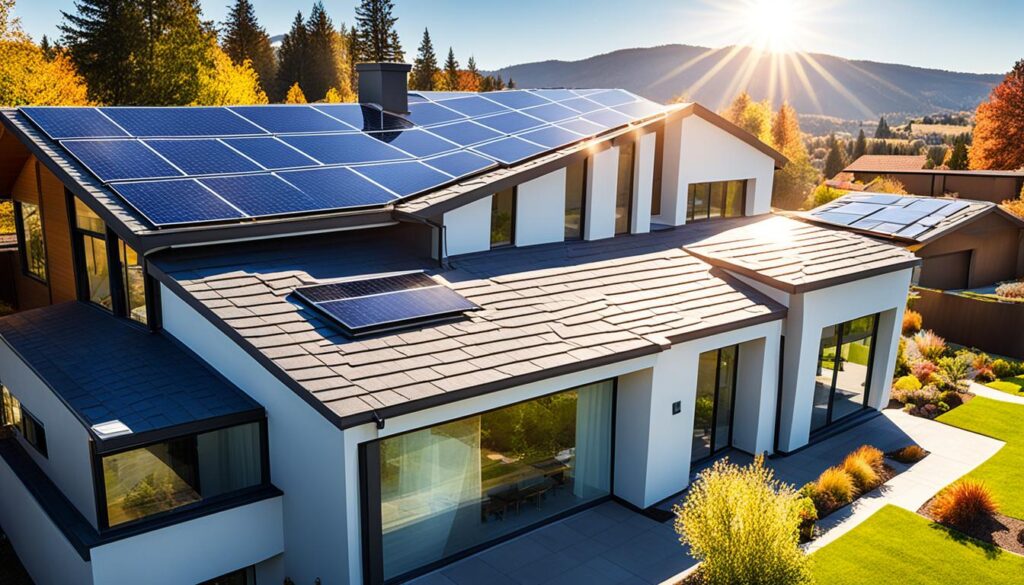A photovoltaic (PV) cell turns sunlight into electricity. It’s a renewable energy source. These cells are often made from silicon.
When sunlight hits them, they create an electric current. This power can be used for devices or to charge batteries.
Many PV cells form PV panels. These panels can be grouped together to make PV arrays. This setup produces more electricity.
You can find photovoltaic systems in many places. They range from small items like calculators to big solar power plants. The technology has gotten better, with solar panels now typically 15-25% efficient.
Thanks to these improvements, photovoltaic technology is helping our world use more sustainable energy sources.
Key Takeaways
- Photovoltaic (PV) cells convert sunlight directly into electricity through the photovoltaic effect.
- PV cells are the basic building blocks of photovoltaic systems, typically made of semiconductor materials like silicon.
- PV cells are assembled into panels and arrays to generate larger amounts of electricity.
- Photovoltaic systems are used in a wide range of applications, from small devices to large-scale power plants.
- The efficiency of PV cells has steadily improved, with commercially available panels reaching 15-25% efficiency.
Understanding Photovoltaic Cells
A photovoltaic (PV) cell turns solar energy into electricity. It does this through the photovoltaic effect. These cells use semiconductor materials like silicon. They are treated to form an electric field. When sunlight hits this material, it creates electron-hole pairs. These pairs separate due to the electric field, leading to an electric current. PV cells include semiconductor layers, conductors, and a coating for light absorption. Through this, they convert sunlight into electricity, which we can use.
The Photovoltaic Effect
When light shines on a photovoltaic cell, it starts an electric current. These cells have specially made semiconductor materials, mainly silicon. These substances create a p-n junction. Sunlight brings photons. They can be absorbed, reflected, or pass through. The photons that are absorbed make the electrons in the semiconductor break free. This leaves behind electron-hole pairs. An electric field then separates these pairs. It pushes the electrons one way and the holes the other. This separation causes an electric current to flow. Through the conductors on the cell, we can use this current to power various things.
what is photovoltaic cell
A photovoltaic cell turns solar energy into usable electricity. It measures how well it does this as efficiency. The top efficiency a cell can have is 33%. This is the Shockley-Queisser limit for single-junction silicon cells. In the real world, most PV panels are between 15% to 25% efficient. Things like not absorbing all energy from light, heat loss, and not catching all the electrons made limit efficiency. But, scientists are finding ways to boost efficiency. They use better materials, different cell designs, and focusing sunlight on cells. Some experimental cells are nearly 50% efficient, but these are usually more expensive. Research keeps making PV technology better and more affordable.
Types of PV Cells
There are many types of photovoltaic cells. They are made from different materials and structures. The common one uses silicon and can be either monocrystalline or polycrystalline. Monocrystalline cells are more efficient, at about 22-26%. Polycrystalline ones are a bit lower, at 16.5-22%. There are also thin-film cells made of materials like cadmium telluride or copper indium gallium selenide. These are light and bendable but less efficient, at 16-22%. Newer types use organic materials or a mix of organic and inorganic. They have lower costs but are still in the lab development phase. Their efficiency is about 23-24%. The choice of cell depends on what’s most important, like cost or efficiency.
| PV Cell Type | Efficiency Range |
|---|---|
| Monocrystalline Silicon | 22-26% |
| Polycrystalline Silicon | 16.5-22% |
| Thin-Film (CdTe, CIGS) | 16-22% |
| Organic Photovoltaic | 23-24% (lab-scale) |
| Perovskite Solar Cells | 23-24% (lab-scale) |

Conclusion
Photovoltaic cells help us use solar energy to make electricity. They are usually made of silicon, a type of semiconductor. When sunlight hits these cells, they create electric current. You can join many cells together to make panels or arrays. These can power anything from a small gadget to a big solar power plant.
The most a PV cell can convert sunlight into electricity is around 33%. But, thanks to ongoing work, the actual efficiency is now between 15 and 25%. Emerging PV technologies, like thin-film and perovskite cells, could do even better. As we move toward using more solar energy, these technologies will get us there smoothly.
Photovoltaic cells are great because they help with getting clean energy. And they’re always getting better, which is good news for fighting climate change. With these improvements, they point to a future that’s kinder to the planet.
FAQ
What is a photovoltaic cell?
A photovoltaic (PV) cell uses sunlight to make electricity. This makes it a renewable energy sources, turning sunlight into power.
How do photovoltaic cells work?
They’re built using materials like silicon. These materials are designed to have a special area called a p-n junction. When sunlight hits this area, it creates an electric current.
What is the photovoltaic effect?
The photovoltaic effect is how a photovoltaic cell makes electricity from sunlight. Sunlight knocks electrons loose in the cell, starting an electric current.
How efficient are photovoltaic cells?
Photovoltaic cells turn about 15% to 25% of sunlight into electricity. The efficiency depends on many things, like the cell’s design and the type of sunlight it gets.
What are the different types of photovoltaic cells?
There are three main types: monocrystalline silicon, polycrystalline silicon, and thin-film materials. Some thin-film solar cells use cadmium telluride or copper indium gallium selenide. Newer types are made of organic materials and perovskites.

